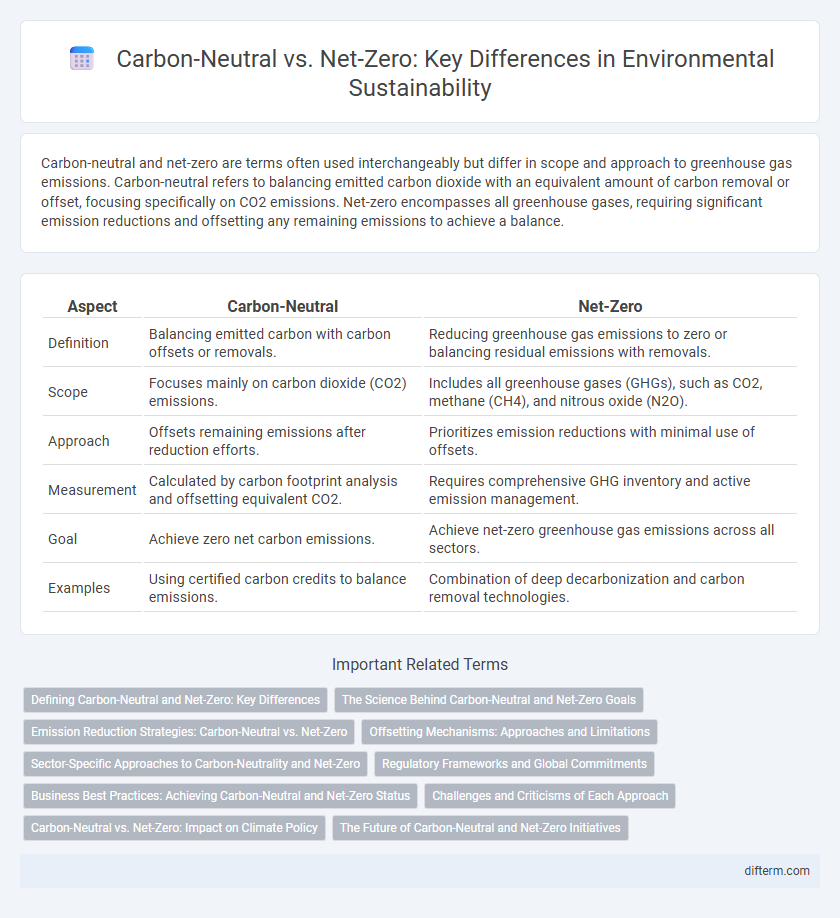Carbon-neutral and net-zero are terms often used interchangeably but differ in scope and approach to greenhouse gas emissions. Carbon-neutral refers to balancing emitted carbon dioxide with an equivalent amount of carbon removal or offset, focusing specifically on CO2 emissions. Net-zero encompasses all greenhouse gases, requiring significant emission reductions and offsetting any remaining emissions to achieve a balance.
Table of Comparison
| Aspect | Carbon-Neutral | Net-Zero |
|---|---|---|
| Definition | Balancing emitted carbon with carbon offsets or removals. | Reducing greenhouse gas emissions to zero or balancing residual emissions with removals. |
| Scope | Focuses mainly on carbon dioxide (CO2) emissions. | Includes all greenhouse gases (GHGs), such as CO2, methane (CH4), and nitrous oxide (N2O). |
| Approach | Offsets remaining emissions after reduction efforts. | Prioritizes emission reductions with minimal use of offsets. |
| Measurement | Calculated by carbon footprint analysis and offsetting equivalent CO2. | Requires comprehensive GHG inventory and active emission management. |
| Goal | Achieve zero net carbon emissions. | Achieve net-zero greenhouse gas emissions across all sectors. |
| Examples | Using certified carbon credits to balance emissions. | Combination of deep decarbonization and carbon removal technologies. |
Defining Carbon-Neutral and Net-Zero: Key Differences
Carbon-neutral refers to balancing emitted carbon dioxide with an equivalent amount of carbon removal or offsetting, effectively resulting in zero net carbon emissions for specific activities. Net-zero encompasses all greenhouse gases beyond carbon dioxide, requiring comprehensive reductions and removals across all emission sources to achieve an overall balance. Understanding these distinctions is crucial for setting accurate corporate sustainability goals and climate policies.
The Science Behind Carbon-Neutral and Net-Zero Goals
Carbon-neutral goals focus on balancing emitted carbon dioxide with an equivalent amount of carbon removal or offset, emphasizing the reduction of CO2 emissions specifically. Net-zero targets extend this concept by accounting for all greenhouse gases, including methane and nitrous oxide, aiming to balance total greenhouse gas emissions with removals to stabilize global temperatures. Scientific models highlight that achieving net-zero emissions by mid-century is crucial to limit global warming to 1.5degC, requiring aggressive emission cuts and technological innovations in carbon capture and renewable energy.
Emission Reduction Strategies: Carbon-Neutral vs. Net-Zero
Carbon-neutral strategies focus on balancing emitted carbon with equivalent offsets, such as reforestation or carbon capture, to achieve zero net emissions. Net-zero approaches emphasize deep emission reductions through energy efficiency, renewable energy adoption, and technological innovation before offsetting any remaining emissions. Both strategies require robust monitoring and verification systems to ensure accountability and environmental integrity in achieving climate goals.
Offsetting Mechanisms: Approaches and Limitations
Carbon-neutral strategies rely on offsetting mechanisms such as reforestation, carbon capture, and carbon credits to balance emitted carbon dioxide, yet their effectiveness is limited by measurement accuracy and permanence of offsets. Net-zero approaches emphasize reducing emissions across all scopes and only use offsets as a last resort, prioritizing systemic changes and technological innovations like renewable energy integration and energy efficiency improvements. Both frameworks face challenges including verification standards, potential leakage, and ensuring that offsets lead to additional, verifiable emissions reductions.
Sector-Specific Approaches to Carbon-Neutrality and Net-Zero
Sector-specific approaches to carbon-neutrality and net-zero prioritize tailored strategies that address unique emissions and energy use within industries such as transportation, manufacturing, and agriculture. In transportation, electrification and sustainable biofuels reduce fossil fuel reliance, while manufacturing relies on energy efficiency improvements and carbon capture technologies. Agricultural sectors focus on soil carbon sequestration and methane emissions reduction, aligning methods to meet carbon budgets and regulatory frameworks relevant to each industry.
Regulatory Frameworks and Global Commitments
Regulatory frameworks for carbon-neutral targets often mandate specific emission reduction milestones and carbon offsetting mechanisms, while net-zero commitments emphasize balancing all emitted greenhouse gases with removal efforts, frequently guided by international agreements such as the Paris Agreement. Countries adopting net-zero goals are generally required to submit detailed climate action plans and transparent progress reports to global bodies like the United Nations Framework Convention on Climate Change (UNFCCC). These frameworks integrate policy instruments like carbon pricing, renewable energy subsidies, and deforestation controls to align national efforts with global climate objectives.
Business Best Practices: Achieving Carbon-Neutral and Net-Zero Status
Businesses achieving carbon-neutral and net-zero status implement comprehensive sustainability strategies including energy efficiency, renewable energy adoption, and carbon offset projects. Measuring scope 1, 2, and 3 emissions allows accurate tracking and reduction targets aligned with Science-Based Targets initiative (SBTi) standards. Transparent reporting and continuous improvement foster stakeholder trust and long-term environmental impact reduction.
Challenges and Criticisms of Each Approach
Carbon-neutral strategies often face challenges related to accurately measuring and offsetting emissions, risking reliance on unverified carbon credits that may not result in real environmental benefits. Net-zero approaches encounter criticism for potentially allowing ongoing emissions as long as they are balanced by removal efforts, which can delay necessary reductions in fossil fuel consumption. Both frameworks grapple with ensuring transparency, accountability, and the integration of sustainable practices to achieve genuine climate impact.
Carbon-Neutral vs. Net-Zero: Impact on Climate Policy
Carbon-neutral initiatives focus on balancing emitted carbon dioxide with equivalent carbon removal to achieve zero net carbon emissions, while net-zero encompasses all greenhouse gases beyond carbon dioxide, aiming for a comprehensive reduction in overall emissions. Climate policies emphasizing net-zero targets typically promote broader systemic changes, including methane and nitrous oxide reductions, compared to carbon-neutral goals that might rely more on offsetting carbon dioxide emissions. Understanding the distinction guides effective environmental regulations and investment in technologies driving sustainable climate outcomes.
The Future of Carbon-Neutral and Net-Zero Initiatives
Carbon-neutral initiatives primarily focus on balancing emitted and offset carbon dioxide to achieve zero net emissions, while net-zero targets encompass a broader range of greenhouse gases, aiming for an overall balance in emissions and removals. Future trends in carbon-neutral and net-zero efforts emphasize advancing renewable energy technologies, enhancing carbon capture and storage methods, and integrating sustainable practices across industries to meet global climate goals. Emerging policies and investments are accelerating innovations that drive accountability, transparency, and measurable impact in reducing carbon footprints worldwide.
carbon-neutral vs net-zero Infographic

 difterm.com
difterm.com